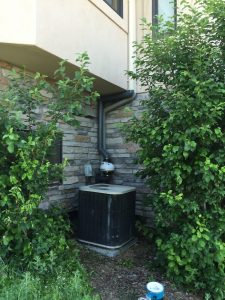13 Jul Interior vs Exterior Radon Mitigation Systems
When it comes time for you to choose which radon mitigation system to install, you’ll be given the option of choosing between interior vs exterior radon mitigation systems. Exterior radon mitigations are far more common than interior ones, but it’s still useful to understand the pros and cons of each so as to better make a decision for your home and personal needs.

Internal Radon Removal Systems
Some of our customers ask us about internal radon mitigation equipment, mainly because they are worried that an external system will be unsightly or difficult to maintain. The main benefit of an internal radon remediation setup is that it is overall more aesthetically pleasing. You don’t have any exposed pipes on the outside of your home, and the pipes simple exit through a small hole in the roof.
However, the pros might not be worth it when exploring the potential drawbacks of an internal radon mitigation system. First of all, internal systems require a lot more work to install – and they are therefore more costly. Pipes must be routed through your home, and often times that means through your garage, closets, and sometimes even your bedroom. And because the pipes are within the walls of your home, they can be potential fire hazards. Lastly, internal radon mitigation equipment requires more piping with more sharp bends. Each bend results in more restricted airflow and less efficiency in allowing radon gases to escape from your home.
Pros
- They look nice
- Blend in with existing roofline
Cons
- More expensive to install
- Fans can get too hot in summer
- Might require running a pipe through rooms/closets
- Must run piping through your garage
- Requires more 90 degree bends, lowering efficiency
- More detailed building codes to follow
External Radon Removal Systems
In light of all the extra complications that installing an internal radon mitigation system involves, many customers opt for an external radon removal system. These systems, while not as outwardly pleasing to the eye, provide a host of benefits (and honestly, they aren’t that distracting from your home’s facade). They are easily serviced since all parts are readily accessible. They require fewer sharp bands and are therefore more efficient in letting of radon gases. And the external radon remediation equipment is much less invasive, and won’t have to be run through your garage, closets, or bedrooms.
Pros
- Servicing and inspection is easy
- Parts are readily accessible
- Don’t have to tear up the roof to install
- No piping running through your rooms or garage
- Fewer 90 degree bends, increasing efficiency
- Better airflow for radon gas to escape
Cons
- They don’t look as nice
- Fans can potentially freeze up in winter
Other Factors to Consider
If you live in a townhome, apartment, or condominium complex, it could be more difficult to get a radon mitigation system installed. We wrote earlier about an instance where a Stapleton resident was denied permission to install a radon mitigation system by her Homeowner’s Association. Regardless of which radon mitigation system you choose to install, you’ll have to jump through some hoops to get approval and to make sure everything is completed up to code.
We offer radon mitigation in Longmont, radon mitigation in Denver, radon removal in fort collins and many more places.

No Comments